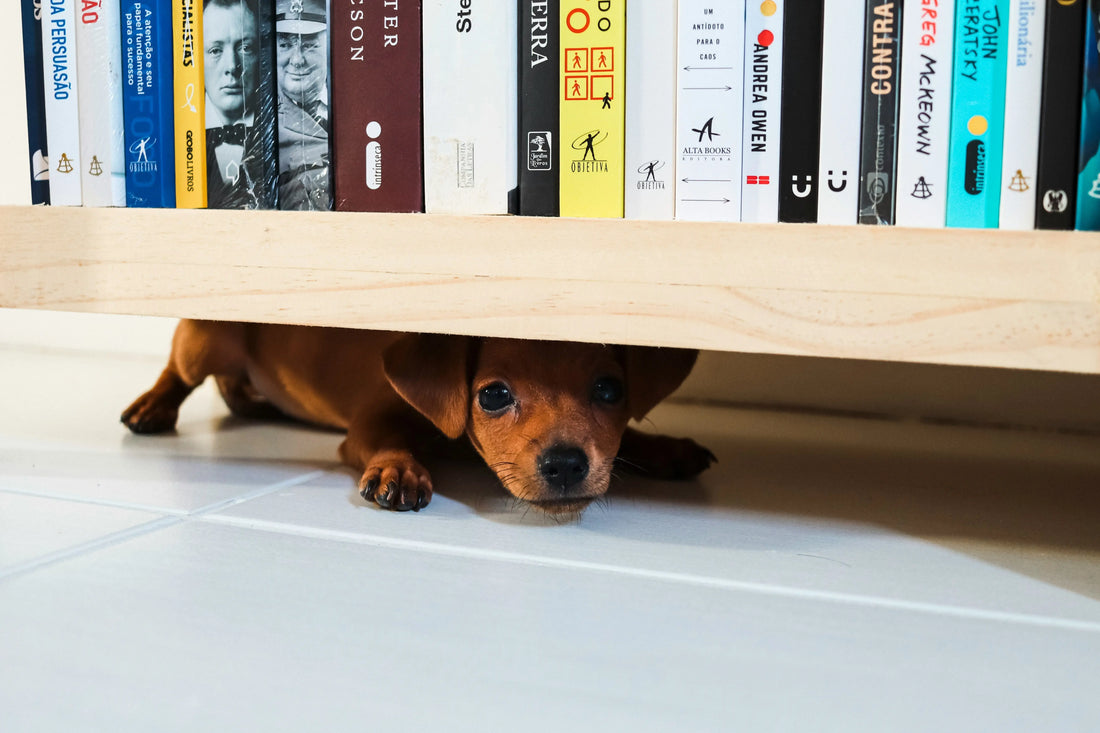
Why does my dog look guilty when he's been naughty?
Share
We’ve all seen it, the dog look guilty face. That look isn't actually what we think it is. You walk into the room to find shredded cushions, chewed-up shoes or an overturned bin and there’s the dog, head down, eyes wide and tail low. It’s easy to assume that your dog is feeling guilty about what they’ve done. But is that really what’s happening? According to research, that so-called "guilty look" may not be what we think it is.
Why Does My Dog Look Guilty?
The "guilty look" is characterised by several classic behaviours, including:
- Lowered head
- Avoiding eye contact
- Flattened ears
- Tucked tail
- Cowering or backing away
- Slow, submissive movements
Dog owners often interpret these behaviours as signs of guilt, believing their dog "knows" they've done something wrong. But according to animal behaviour experts, this reaction is less about guilt and more about fear and submission.
Do dogs feel guilt like humans do?
We experience guilt as a complex emotional response. It requires a sense of self-awareness, the ability to understand right from wrong, and a knowledge of consequences. While dogs are smart, studies suggest that they do not have the same capacity for guilt as people do.
Instead, dogs experience emotions like fear, excitement, and anxiety. Their so-called “guilty look” is actually a response to our body language, tone of voice, and facial expressions. If we walk into a room looking upset or scolding them, they pick up on those cues and display submissive behaviours. Dogs aren’t reflecting on their actions, they’re reacting to ours.
A study published in Behavioural Processes explored the concept of guilt in dogs. The researchers found that dogs displayed the “guilty look” regardless of whether they had actually misbehaved. In some cases, dogs that had done nothing wrong still showed signs of "guilt" when confronted by an owner with an angry or disapproving tone. This shows that the behaviour isn’t linked to the dog's actions but to how the owner behaves upon entering the room.
Why do dogs give us “the look”?
If dogs don’t feel guilt, why do they look so guilty? The answer lies in how dogs communicate with people. Dogs have evolved to live alongside us for thousands of years, learning to read our facial expressions, body language, and tone of voice. When they detect signs of disapproval, they offer appeasement behaviours to avoid conflict.
Appeasement behaviours are a form of non-verbal communication used by dogs to de-escalate tense situations. By making themselves look small and non-threatening – lowering their head, tucking their tail and avoiding direct eye contact – they are signalling that they don’t want to fight. This behaviour is common in wolf packs, where subordinate wolves will use appeasement signals to avoid confrontation with higher-ranking members.
When a dog gives us the "guilty look," they aren’t reflecting on their mistakes, they’re trying to calm us down. The dog sees our scowl, hears a sharp tone and recognises that something is wrong. Their body language is a way of saying, "Please don't be angry with me," not "I feel bad about chewing your shoes."
What should you do if your dog misbehaves?
If our dogs have done something naughty the first instinct is often to tell them off. But if the “guilty look” is actually an appeasement signal, that may do more harm than good. Here’s how to approach it instead:
-
Avoid punishment after the fact: Dogs live in the present. If you punish your dog after the incident, they won’t connect the punishment with their earlier behaviour. They’ll only connect it with your current actions, which can make them anxious around you. This is why the "guilty look" happens even if your dog didn’t do anything wrong.
-
Catch them in the act: If you catch your dog chewing your shoes or jumping on the sofa, calmly intervene and redirect them to a more appropriate behaviour (like chewing on a toy or sitting quietly). This helps your dog learn what’s expected of them in real time.
-
Focus on positive reinforcement: Instead of punishing bad behaviour, reward good behaviour. For example, if your dog chews their toy instead of your shoes, give them lots of praise. This encourages them to repeat the good behaviour in the future.
- Remove temptation: Dogs are opportunistic, and if a tasty-smelling bag of rubbish is within reach, they may not be able to resist. By keeping tempting items out of reach, you reduce the chances of "naughty" behaviour in the first place.
Instead of scolding your dog for bad behaviour, focus on training, positive reinforcement, and managing the environment to prevent problems before they start. Your dog might not feel guilty, but they’ll certainly appreciate the love and patience you show them.
